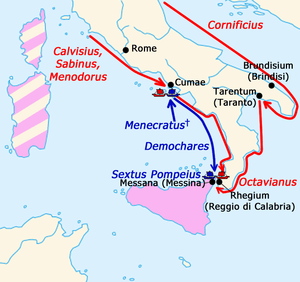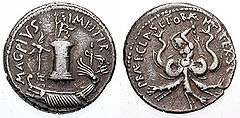Sextus Pompey
Sextus Pompeius Magnus Pius, in English Sextus Pompey (67 BC – 35 BC),[1] was a Roman general from the late Republic (1st century BC). He was the last focus of opposition to the Second Triumvirate. His father was Gnaeus Pompeius Magnus (Pompey the Great). Shakespeare had him as a major character in his play Antony and Cleopatra (1606–07).
Biography

Sextus Pompeius was the youngest son of Pompey the Great (Gnaeus Pompeius Magnus)[1] by his third wife, Mucia Tertia. His older brother was Gnaeus Pompeius. Both boys grew up in the shadow of their father, one of Rome's best generals and an originally non-conservative politician who drifted to the more traditional faction when Julius Caesar became a threat.
When Caesar crossed the Rubicon in 49 BC, thus starting a civil war, Sextus' older brother Gnaeus followed their father in his escape to the East, as did most of the conservative senators. Sextus stayed in Rome in the care of his stepmother, Cornelia Metella. Pompey's army lost the Battle of Pharsalus in 48 BC and Pompey himself had to run for his life. Cornelia and Sextus met him in the island of Lesbos and together they fled to Egypt. On the arrival, Sextus watched his father being killed by treachery on September 29 of the same year. After the murder, Cornelia returned to Rome, but in the following years Sextus joined the resistance against Caesar in the African provinces. Together with Metellus Scipio, Cato the Younger, his brother Gnaeus and other senators, they prepared to oppose Caesar and his army to the end.
Caesar won the first battle at Thapsus in 46 BC against Metellus Scipio and Cato, who committed suicide. In 45 BC, Caesar managed to defeat the Pompeius brothers in the Battle of Munda, in Hispania (the Iberian Peninsula, comprising modern Spain and Portugal). Gnaeus Pompeius was executed, but young Sextus escaped once more, this time to Sicily.
Back in Rome, Julius Caesar was killed on the Ides of March (March 15) 44 BC by a group of senators led by Cassius and Brutus. This incident did not lead to a return to normality, but provoked yet another civil war between Caesar's political heirs and his killers. The Second Triumvirate was formed by Octavian, Mark Antony and Lepidus, with the intention of avenging Caesar and subduing all opposition. Sextus Pompeius in Sicily was certainly a rebellious man, but the faction of Cassius and Brutus was the second triumvirate's first priority. Thus, with the whole island as his base, Sextus had the time and resources to develop an army and, even more importantly, a strong navy operated by Sicilian marines.
Brutus and Cassius lost the twin battles of Philippi and committed suicide in 42 BC. After this, the triumvirs turned their attentions to Sicily and Sextus.

↗ — actions of Sextus' admirals.
But by this time, Sextus was prepared for strong resistance. In the following years, military confrontations failed to return a conclusive victory for either side, although in 40 BC Sextus' admiral, the freedman Menas, seized Sardinia from Octavian's governor Marcus Lurius.[1] In 39 BC, Sextus and the triumvirs signed for peace in the Pact of Misenum. The reason for this peace treaty was to secure the West before the anticipated campaign against the Parthian Empire. Antony, the leader of Rome's eastern provinces, needed a large number of legions for the coming campaign, which would take his army (ostensibly) through Mesopotamia, Armenia, and Parthia. Thus an armistice with Sextus' large forces on Sicily proved useful.

↗ — actions of Octavianus and his commanders;
↗ — actions of Sextus Pompeius and his commanders.
However, the peace did not last for long. In Antony's absence, Octavian renewed the conflict against Sextus. Sextus and Octavian accused one another of violating the terms of the Pact of Misenum, but the final straw was the betrayal of Sardinia to Octavian by Menas. Octavian was defeated in the naval battle of Messina (37 BC), so he now turned to his friends Marcus Vipsanius Agrippa and Titus Statilius Taurus, both very talented generals. In addition, the third triumvir, Marcus Aemilius Lepidus, raised 14 legions in his African provinces to help defeat Pompey. Agrippa spent the winter training a navy on land and building a fleet near Lake Avernus. Agrippa fought Sextus at Mylae in August 36 BC, and again a month later, while Lepidus and Statilius Taurus invaded Sicily. In the Naulochus cape.[1] Agrippa destroyed the remainder of Sextus' fleet. Sextus escaped to Asia Minor[1] and, by abandoning Sicily, lost his only base of support.
Sextus Pompeius was caught in Miletus in 35 BC and executed without trial by order of Antony via Marcus Titius, whom Sextus had once spared. Although Octavian later pretended the execution without a trial of Sextus was illegal because Sextus was a Roman citizen, Octavian himself had declared Sextus an outlaw without citizen rights.
Sextus had married Scribonia, a distant relative of his. Scribonia was the daughter of Lucius Scribonius Libo, consul of 34 BC and the niece of another Scribonia, the second wife of Octavian. Sextus and Scribonia had a daughter and only child called Pompeia Magna. As an affine to both Sextus and Octavian, Scribonius Libo had played a role in brokering peace between Sextus and the Triumviri, and had very reluctantly abandoned Sextus in 36/35, in return for which he had received the consulship.
Chronology
- 48 BC – in Egypt with his father, who is assassinated
- 47/45 BC – resistance in Africa
- 45 BC – defeated in Munda
- 42 BC – controls Sicily with a powerful navy
- 39 BC – pact of Misenum with Octavianus and Antony
- 37 BC – defeats Octavian off Messina
- 36 BC
- August, defeats Octavian
- September, defeated by Agrippa off Naulochus (Sicily)
- 35 BC – captured and executed in Asia Minor (Miletus)
Dramatic representations
- British actor Donald Sumpter portrayed Sextus Pompey in the BBC Shakespeare television production of Antony and Cleopatra (1981).
- American actor Walter Koenig portrayed Sextus Pompey in the Bard Productions television production of Antony and Cleopatra (1983).
References
External links
- Sextus Pompey - biography at unrv.com
- Coins of Sextus Pompeius
![]() Media related to Sextus Pompeius at Wikimedia Commons
Media related to Sextus Pompeius at Wikimedia Commons
